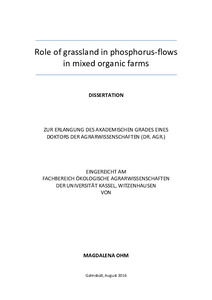| dc.date.accessioned | 2017-09-28T09:13:55Z | |
| dc.date.available | 2017-09-28T09:13:55Z | |
| dc.date.issued | 2017-09-28 | |
| dc.identifier.uri | urn:nbn:de:hebis:34-2017092853498 | |
| dc.identifier.uri | http://hdl.handle.net/123456789/2017092853498 | |
| dc.description.sponsorship | Thünen-Institut für Ökologischen Landbau, Trenthorst | ger |
| dc.language.iso | eng | |
| dc.rights | Urheberrechtlich geschützt | |
| dc.rights.uri | https://rightsstatements.org/page/InC/1.0/ | |
| dc.subject | Grassland | eng |
| dc.subject | Phosphorus | eng |
| dc.subject | nutrient management | eng |
| dc.subject | Organic farming | eng |
| dc.subject | crop rotation and management | eng |
| dc.subject | P budgets | eng |
| dc.subject | grazing | eng |
| dc.subject | phosphorus-cycle | eng |
| dc.subject.ddc | 630 | |
| dc.title | Role of grassland in phosphorus-flows in mixed organic farms | eng |
| dc.type | Dissertation | |
| dcterms.abstract | The aim of the study is to analyze the role of grassland in phosphorus (P) flows in mixed organic farms. The research farm of the Thünen Institute of Organic Farming, Trenthorst, located in northern Germany was used for the analyses. The farm converted to organic farming in 2001 and had no P-fertilizer import. Grassland-related P flows (by grazing and harvesting) were estimated with a specific method using a calibrated rising plate meter (DM = 100.41 x h + 1 (r²=0.7549; n=396)). Inner farm nutrient cycles were calculated with farm specific data for the dairy farm system for the years 2010 - 2012 based on a complete material flow model. The development of soil P characteristics of grassland and arable land after twelve years of organic farming was determined by P fractions, and the activities of phosphatases and dehydrogenase in the soil.
The 116 ha sized farm showed deficits of 1,105 kg P yr-1 (7.9 kg P ha-1 a-1 in permanent grassland and 10.9 in arable land) which were supplied from soil P reserves. Maize (30.5 kg P ha-1 a-1), grass-clover (23.9 kg P ha-1 yr-1) and mixed faba bean and oats (19.8 kg P ha-1 a-1) had the highest P uptake in cropland. At grassland, grazing intake by livestock was 15.9 kg P ha-1 a-1 (± 2.7, min. 9.5, max. 20.7). Grazing and feed conserves from grassland accounted for 29.2 % of the P supply for the dairy cows and directly fed arable land with 64 kg P (average 1 kg P ha-1 yr-1).
In arable land plant available P-contents in topsoils (0-30 cm) of the analyzed farm were still sufficient, but had decreased since converting to organic farming due to negative P balances. The readily available inorganic P fractions (H2O-P, NaHCO3-P) were also lower in 2013 than in 2001.The content of plant available P (CAL) in topsoils generally reduced from 65 mg kg-1 over twelve years to 61.3 mg kg-1. In grassland between 2001 and 2013 the P (CAL) values reduced from 132.0 to 107.1 mg kg-1. Above all, soil P mining has not yet endangered soil fertility, according to high P (CAL)-contents in the soils. Therefore, it might further serve as P reserve in the farm cycle for a limited time period.
Forced biological P cycling on farms and integration of grassland P in fertilizing strategies might be part of a solution until safe systems of P recycling from the food chain in agriculture are installed, not only in organic farming. Knowledge transfer into practise and societal awareness for non-renewable resources – like P – needs to be raised. | eng |
| dcterms.accessRights | open access | |
| dcterms.creator | Ohm, Magdalena | |
| dc.contributor.corporatename | Kassel, Universität Kassel, Fachbereich Ökologische Agrarwissenschaften, Fachgebiet Ökologischer Land- & Pflanzenbau | |
| dc.contributor.referee | Rahmann, Gerold (Prof. Dr.) | |
| dc.contributor.referee | Heß, Jürgen (Prof. Dr.) | |
| dc.subject.swd | Grünland | ger |
| dc.subject.swd | Biologische Landwirtschaft | ger |
| dc.subject.swd | Phosphor | ger |
| dc.subject.swd | Nährstoffversorgung | ger |
| dc.subject.swd | Fruchtfolge | ger |
| dc.subject.swd | Beweidung | ger |
| dc.date.examination | 2017-05-04 | |

